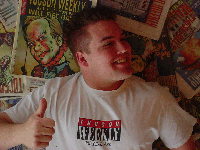"Its the greatest paper in Tucson," exclaims Jon Hobson, a University of Arizona journalism student and the author of one Weekly article. "It's more interesting than the Star and Citizen and I read it more religiously than them." When he moved here four years ago, Hobson adds, the Weekly allowed him to learn about the city quickly through its political coverage, dining reviews and entertainment section.
Another relative newcomer to Tucson, Diane Senders, agrees. "I found it gave me more information about free events," the five-year resident says. She also likes the Currents articles, believing they tell her something about what is really going on locally. Senders, however, thinks the City Week section is not as useable as it once was because of format changes, a problem that's been addressed by the Weekly's new layout.
The view from the GOP side of the aisle is mixed, at best. Ed Parker, of the Pima County Republican Party, says he glances at the The Skinny occasionally but otherwise doesn't read the Weekly. And when offered an opportunity to comment on the Weekly, a representative of the Southern Arizona Leadership Council declined the chance.
Longtime local Democratic political campaigner Lyn Wilson has a different perspective. She was involved in publishing a similarly named publication, the Tucson Weekly News, back in the early 1980s, which she characterized as radically left of center. When the Tucson Weekly first appeared, she felt it was lightweight and lacked substance.
Wilson also holds strong views about the current Weekly. She thinks it has attacked some environmentally friendly politicians it should have supported.
"I don't like it as much as I used to, and I only read the articles which interest me personally," she says. "A lot of time and money are put into the personal ads, which I find somewhat offensive."
Community activist Jake Elkins sides with Wilson. "The Weekly barely functions as an alternative newspaper," he laments, "and it was better before. Now, it is never very harsh on the biggest players in Tucson, like Raytheon, the University of Arizona or Davis-Monthan Air Force Base." He alleges that the paper wouldn't do a story that had negative impacts on the real-estate industry.
Elkins' friend, Pat Malchow, uses more subtle language to express her disappointment in the Weekly. "Its tilting away from clarity toward obfuscation," she says. "In the past, it had a clear sense of what the community is, but now, it is moving toward the agendas of the other press in town." Believing there are small but subtle shifts in how the Weekly looks at the world, Malchow thinks these changes will result in many people in Tucson no longer having any media voice.
John Laswick has been involved with the arts downtown for almost 20 years, and he also thinks some of the changes at the Weekly haven't been for the better. Back in the 1980s, he says, the publication was helpful in saving the Temple of Music and Art and in rallying the community to support the creation of a downtown Arts District. But now he thinks the paper has become too strident and negative.
"In the late '90s," Laswick says, "the Weekly got a little too far into being critical without being constructive. When it is not as personal, I think it serves a better role. When it brings out issues without attacking individuals, it is more effective."
Midtown resident Ken ODay sees things differently. "For investigative reports, the Weekly is the best source of local news. The other newspapers don't do enough of that, and the Weekly picks up the slack." Having read the paper for 10 years, ODay also finds The Skinny useful, and he enjoys the comics and movie reviews.
University of Arizona journalism professor emeritus George Ridge began looking at the Weekly many years ago, and now calls it "a must-read every week." He says he likes The Skinny because it does a good job at revealing inside political goings-on in town, but he thinks the column recently has looked like it was based on press releases.
Ridge believes the newspaper has become a little tamer over time, and that it's not as cantankerous as it use to be. But he still reads the entire Weekly for information, and has special praise for the new Noshing Around column in Chow. "I like the background restaurant column," he says. "It's insightful and (it has) gotten into material which is new to me."
World War II veteran Manny Herrera also started reading the Weekly when it first appeared and still enjoys its frankness. But, he says, there is a problem with the publication. "If I don't pick it up on Thursday, they're all gone by Saturday."








